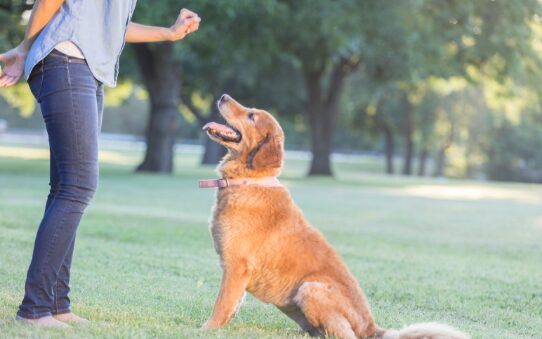Why Dog Training is Essential for a Happy and Well-Behaved Pet

Dog owners who invest in proper training report higher satisfaction and stronger bonds with their pets. As Brisbane dog training experts have observed, well-trained dogs not only bring joy to their families but also show reduced risks of physical and mental health issues like cardiovascular disease, hypertension, loneliness, and anxiety.
A well-trained dog gets the mental stimulation needed to prevent destructive behaviours such as excessive barking, digging, and chewing household items. Our experience shows that trained pets stay safer around family and friends and avoid dangerous situations. On top of that, socialisation and obedience classes are a great way to get opportunities for dogs to interact with other pets and people. These interactions help prevent behavioural issues like aggression and fearfulness.
In this piece, we’ll show you how training shapes your dog’s development and the proven techniques to build a happy, well-behaved companion.
Understanding Dog Training Basics
Modern dog training has changed a lot over the years. These days, we focus on positive reinforcement techniques. Dogs learn best through rewards – treats, toys, or praise work great to encourage good behaviour. They also do better with clear boundaries and regular routines that help them understand what we expect.
Puppies learn fastest between 8 to 16 weeks old, making this the perfect time to start training. Don’t worry if you have an older dog though – that old saying about teaching new tricks isn’t true. Dogs can pick up new skills at any age with the right guidance.
Here are the fundamental principles of effective dog training:
- Use consistent commands and reward systems across all family members
- Keep training sessions short (about five minutes each)
- Practise in different environments to reinforce learning
- Maintain patience and avoid physical punishment
- Focus on rewarding good behaviour rather than punishing mistakes
Your choice of training method makes a big difference in how well it works. Force-free trainers get great results by using positive reinforcement. This approach builds a strong bond between dogs and their owners. It also avoids the negative mental effects that often come with punishment-based training.
Professional training classes give you a structured way to learn, but many people train their dogs successfully at home. Success comes down to having a solid plan, the right equipment, and daily practise. This steady approach helps dogs learn what you expect from them and develop better habits naturally.
The Science Behind Dog Training
Science has uncovered the sort of thing I love about how dogs think and learn. Dogs process language like humans do. They use their brain’s left side to understand words and the right side for tone. Brain scans showed that a dog’s reward centres light up when they hear familiar words spoken in a friendly voice.
We learned that dogs pick up new behaviours through two main ways: classical conditioning and operant conditioning. Classical conditioning helps dogs make automatic connections between different triggers. Operant conditioning teaches them about results of their actions. Dogs that learned scent work showed better self-control and stuck to their tasks longer than other dogs.
Studies revealed how different training styles affect dogs:
- Dogs that faced harsh training methods showed signs of stress 15 times more often than those trained with treats and praise
- Stress behaviours appeared in 65% of dogs trained with punishment, while only 8% of positively trained dogs showed these signs
- Dogs trained only with harsh methods showed more ‘pessimistic’ responses in thinking tests
The science backs it up – positive reinforcement builds stronger bonds between humans and dogs. Dogs learn better with reward-based training and develop more stable emotional connections. This approach not only works better but also protects our furry friends’ mental health.
Building a Training Foundation
You need a solid training foundation that starts with realistic goals and regular routines. Your first step should be to break training into short 5-10 minutes sessions. This simple approach keeps your dog excited about learning and prevents them from getting tired.
The early stages of training should focus on seven simple commands: stop, down, sit, heel, stay, leave it, and recall. These commands are the life-blood of all future training and create clear communication between you and your dog. Your training schedule needs to be regular – quick daily sessions work better than long, sporadic ones.
A well-laid-out daily routine will help your puppy feel secure and know what to expect. We focused on:
- Regular potty breaks
- Scheduled feeding times
- Dedicated training periods
- Consistent rest intervals
Dogs learn best with realistic goals that match their unique needs. Your training plan should reflect your dog’s age, breed traits, and current abilities. A young puppy needs socialisation and simple commands, while an older rescue dog might need more work on changing behaviours.
Start practising these skills in a quiet, familiar space before you add distractions. This step-by-step approach builds your dog’s confidence and lets them master each command before moving to tougher situations.
Conclusion
Scientific research and hands-on experience show that good dog training creates happier, more confident pets and deepens the bond between dogs and their owners. Dogs develop key skills while protecting their mental health through consistent positive reinforcement and well-laid-out routines.
Simple commands come first, and dogs build confidence as they progress to complex behaviours at their own pace. Training needs patience and dedication, but having a well-trained companion makes all the work worth it.
Each dog learns differently, so training methods must match their unique personalities and needs. Positive reinforcement techniques work best with young puppies and older rescue dogs alike. These methods build trust between pets and their owners.





